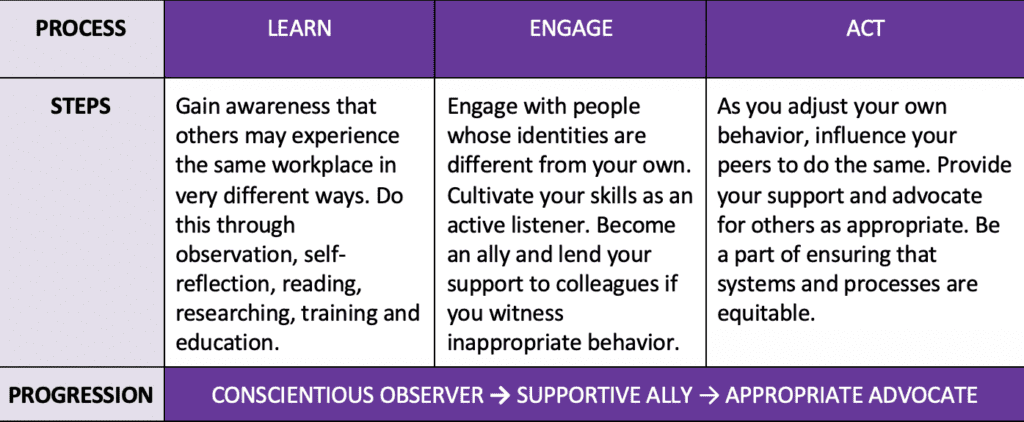If you’re in the workplace feeling minimized, demeaned or overlooked, how would you want to be supported by your colleagues? Understanding how underrepresented individuals might respond to this question can help inform how to shape a journey that leads to a more diverse, equitable and inclusive work environment. But it also starts with knowing how individuals in your organization may be affected by a negative work environment.
Effects of the toxic workplace
People who feel excluded, misunderstood or constantly ridiculed in the workplace can suffer trauma that significantly affects their lives, at work and beyond. Research conducted by Manuela Priesemuth, assistant professor of management at Villanova University posits that “toxic workplaces impair the lives of individuals beyond the work realm.” In addition to struggling at work, “employees report feeling emotionally drained, experiencing lower well-being, and even increased conflict at home.”
Destructive workplaces are devastating for all concerned, individuals, work teams and the whole organization. In her multi-study effort, Priesemuth and her colleagues discovered that abusive environments degrade a work group’s effectiveness, to where they lose their confidence to adequately perform a given task. Such environments can also “destroy important bonds between team members, which further results in reduced performance and citizenship behaviors, meaning that employees are less likely to help and support each other.”
Building a supportive culture
Building a supportive culture is key to creating a diverse, equitable and inclusive work environment. While everyone is harmed when exposed to a negative workplace, people from underrepresented or marginalized groups are particularly at risk. Providing them with support means committing to DEI in the form of education, training and other initiatives that engage everyone in the organization. It also includes self-reflection on what it means to provide meaningful support.
In practice, shaping a diverse, equitable and inclusive environment requires individuals and organizations to advance the interests of others, speak up for marginalized groups, commit to improving circumstances for everyone and follow up on those commitments with actions. Anyone in the organization can and should do this, regardless of their background or identity. The framework below offers a process to guide employees and organizations to advance through this journey. To affect change in an intentional and constructive way, each step should be taken before moving on to the next, progressing from learning as a conscientious observer to engaging and acting as an ally and advocate. It’s worth mentioning that there’s been much debate around the terms ally and advocate, with varying definitions. At the heart of it, both concepts involve moving forward with supportive actions. As you look at this framework, consider, where do your employees lie on this spectrum and where do you want them to be?

Your approach affects the outcome
Advancing DEI requires nuance and sensitivity. Good intentions can and do backfire. Focusing on the outcome, rather than the act itself can help steer you in the best direction. To bring this to life, let’s look at a specific example. You are in a meeting, and you notice that one person, who is part of an underrepresented group, is constantly overlooked or interrupted—as the conversation is dominated by others who seem oblivious to their own behavior. You want to advocate on that person’s behalf. Let’s look at two approaches, each with a different effect.
Explicit: You say directly to the group that they are marginalizing and demeaning a member of the team. You put it to the group facilitator that they must do a better job of including that person. The likely effect is that group members are stunned, the facilitator is defensive and the underrepresented person feels singled out and embarrassed. The act becomes the focus, rather than the intent of the act. In this situation, a direct appeal could have a polarizing effect.
Implicit: You say that you’ve heard the underrepresented person offer interesting ideas on certain points covered in the meeting. You ask if that person would be willing to share their thoughts with the group. The likely effect is that the person feels supported and empowered to share their opinion. The focus is not on the act, but rather on the intent of the act, inclusivity and collaboration.
The choice of approach matters. The degree of the action required should always be appropriate to the circumstances and preferences of the underrepresented person (or people) involved. Consider…how does the underrepresented person want to be supported? Does the situation call for a direct approach, or will more subtle contribution be more effective and appropriate?
Many organizations are working with employees to help answer these questions and some are going further, elevating their commitment to DEI by developing organization-wide programs of support.
The journey to advance diversity, equity and inclusion applies both at the micro-level with interpersonal situations among employees as well as at the macro level. In part two of this series on DEI, we’ll explore how organizations can make enterprise-level changes to demonstrate advocacy in their community, the nation or even on the global stage.












